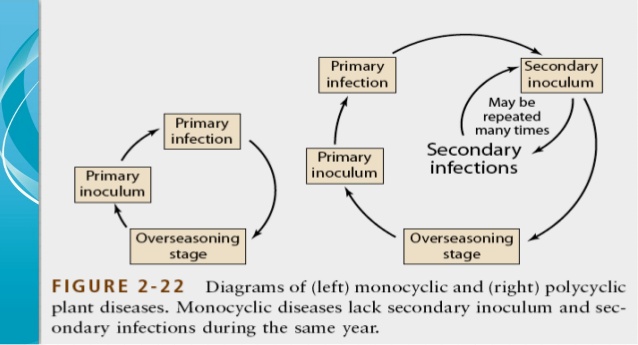
Forecast based on initial and secondary inoculum
Forecasts Based on Amounts of Initial and
Secondary Inoculum
In apple scab (caused by the fungus Venturia inaequalis),
the amount of initial inoculum (ascospores) is usually
large and is released over a period of 1 to 2 months
following bud break. Infections from the primary
inoculum must be prevented with well-timed fungicide
applications during blossoming, early leafing, and fruit
development; otherwise, the entire crop is likely to
be lost. After primary infections, however, secondary
inoculum (conidia) is produced, which multiplies itself
manyfold with each succeeding generation. The
pathogen can infect wet leaf or fruit surfaces at a range
of temperatures from 6 to 28°C. The length of time that
leaves and fruit need to be wet, however, is much shorter
at optimum temperatures than at either extreme (9
hours at 18–24°C versus 28 hours at 6 to 28°C). By
combining temperature and leaf wetness duration data,
the apple scab forecast system can predict not only
whether an infection period will occur, but also whether
the infection periods will result in light, moderate, or
severe disease (Fig. 8-24). Such information, collected
and analyzed by individuals or by weather-sensing
microcomputers, is used to make recommendations to
growers. The latter are advised of the need and timing
of fungicide application and about the kind of fungicide
(protective or eradicant) that should be used to control
the disease.
In wheat leaf and stem rusts (caused by fungi Puccinia
recondita and Puccinia graminis), short (1–2 week)
forecasts of subsequent disease intensity can be obtained
by taking into account disease incidence, stage of plant
growth, and spore concentration in the air.
In many insect-transmitted virus diseases of plants
(e.g., barley yellow dwarf, cucumber mosaic virus, and
sugar beet yellows), the likelihood, and sometimes the
severity, of epidemics can be predicted. This is accomplished
by determining the number of aphids, especially
viruliferous ones, coming into the field at certain stages
of the host growth. A number of the aphids caught in
traps placed in the field are tested for virus by allowing
them to feed on healthy plants or by analyzing them for
virus serologically with the ELISA technique or with
nucleic acid probes. The more numerous the viruliferous
aphids and the earlier they are detected, the more
rapid and more severe will be the virus infection. Such
predictions can be improved by taking into account late
winter and early spring temperatures, which influence
the population size of the overwintering aphid vectors.


